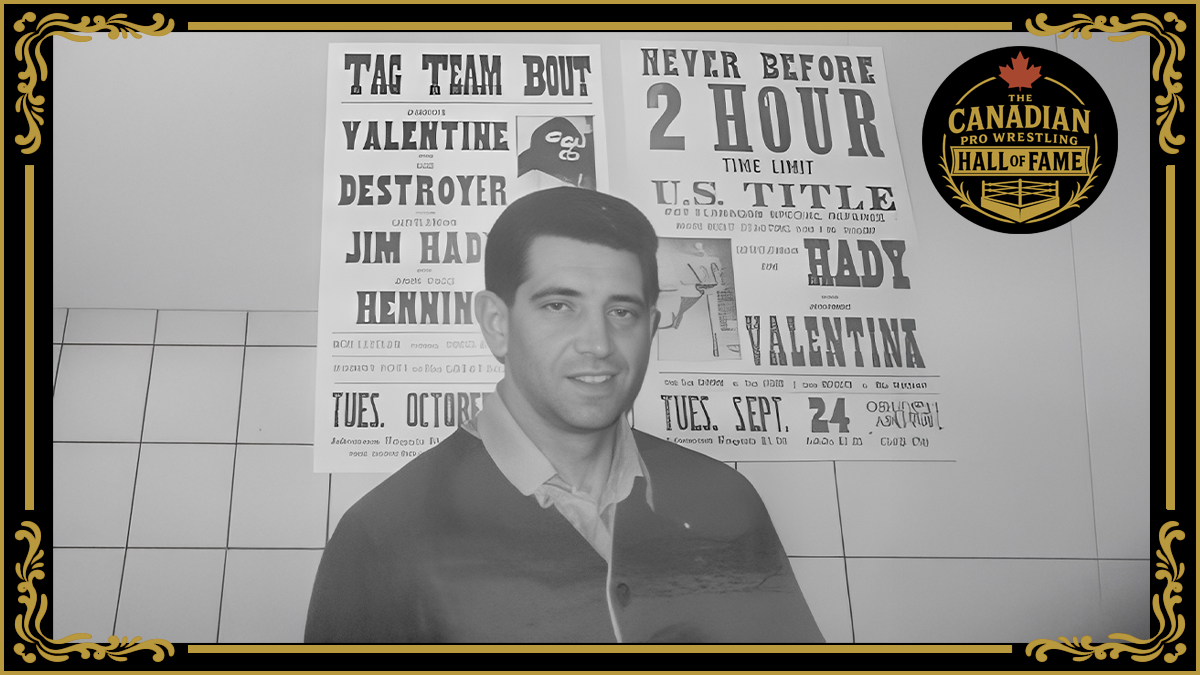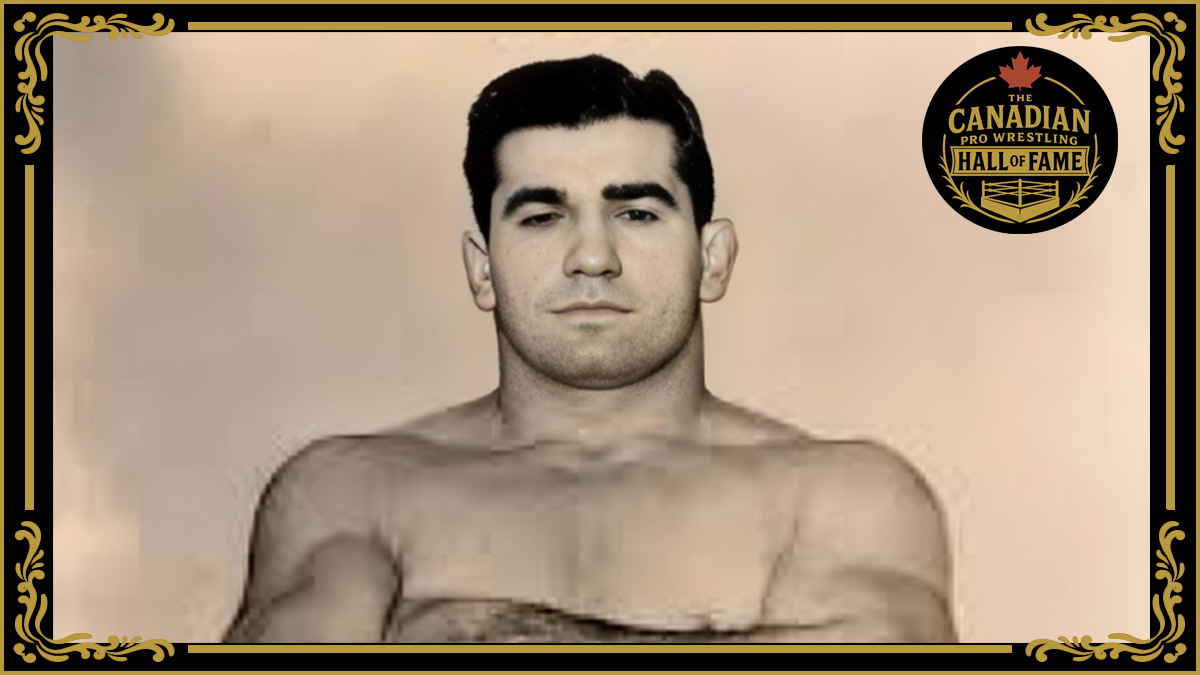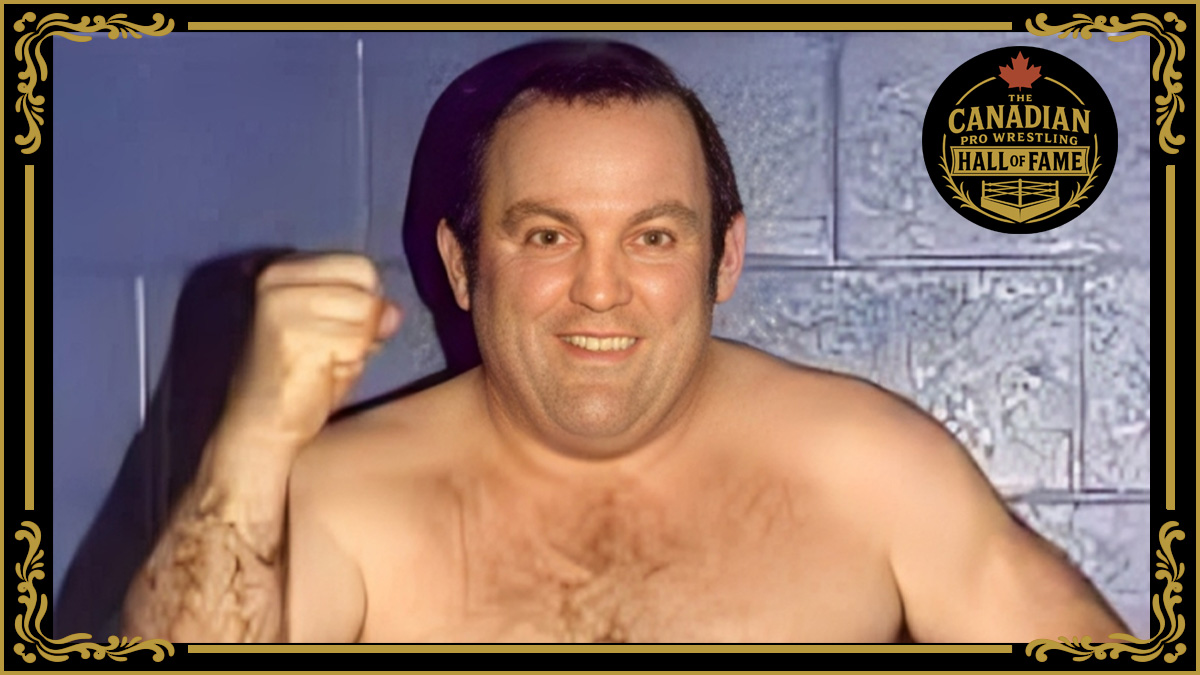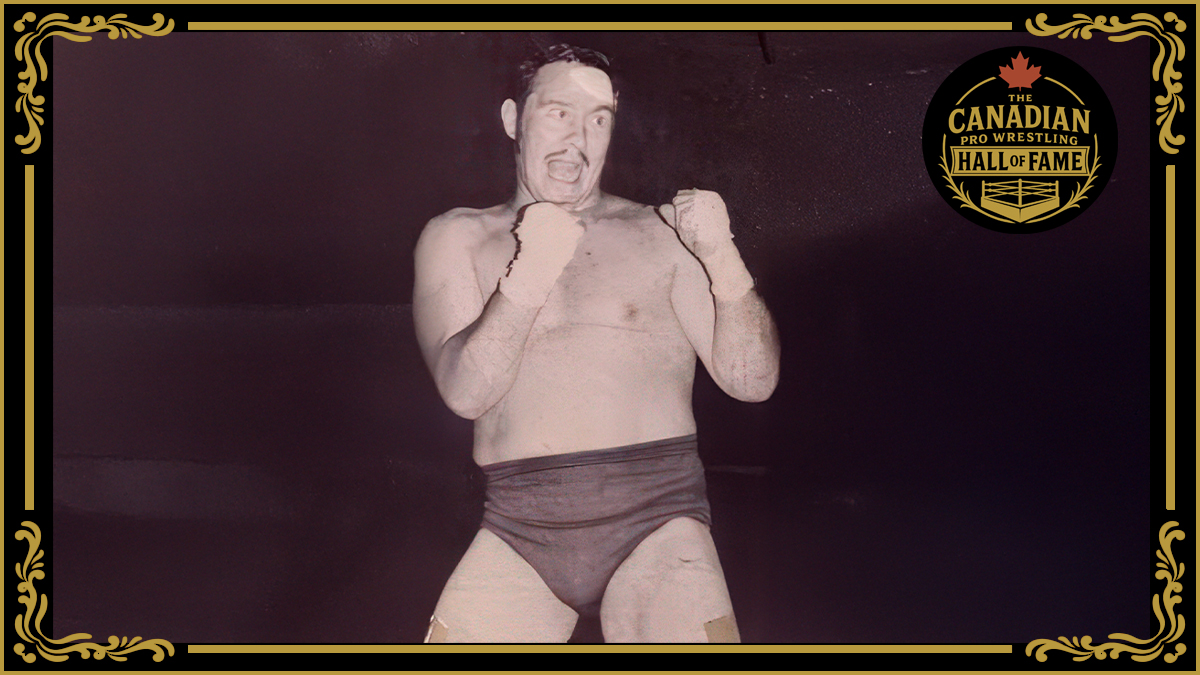Wrestling broadcast pioneer Barry Lloyd Penhale covered the Golden Age of the sport in print for WAYLI magazine in his Canadian Corner column, up in the gondola at Maple Leaf Gardens for weekly radio shows, and later in television for Northland Wrestling. Ask him about the history of Ontario pro wrestling and the names start rolling.
While Frank Tunney, the Toronto promoter for 50 years, kicks off the conversation, Penhale is quick to point out that his associate promoters around the province were an integral part of the entire operation. There was John Katan, the long-time Hamilton promoter, Joe Maich in Brantford and area, Larry Kasaboski, the king of the Northland, and in the East, Pat Milosh, the promoter in Oshawa and surrounding towns for more than 40 years.
Milosh would leave an indelible mark on the Oshawa sports community from the 1940s to the 1990s but his story begins in southeastern Europe in 1926.
Born in Grajesnica, Macedonia, on March 17, 1926, Milosh was a surviving twin to parents Magdalena and Peter. In 1937, the Milosh family would leave their native country, immigrating to Canada and embracing their new life in Oshawa, Ontario, an emerging automotive center east of Toronto. Originally living on Gibbons St., just north of Bond St., the family subsequently moved to 64 Bond St. in downtown Oshawa. The family — Peter and Magda and three children Pat, George, and Kay — knew they would have to work hard to make it in Canada, learning the language and immersing themselves in the local culture.
At an early age Pat would be drawn into physical fitness and sports with a keen eye towards boxing and wrestling. Pat’s son, Alex Milosh, said that as a youngster his father would strap on a back sack, filled with rocks for weight, and run down Simcoe Street to Lake Ontario and back — a round trip of approximately seven miles — on a daily basis. As well, Pat would lift weights on a daily basis and pedal his bicycle for numerous miles to build his strength and endurance. In the days before elaborate fitness equipment Pat would hone an impressive physique and pursue his love of the physical sports in his teenage years.
Peter Milosh relied on his children to run the Casino Restaurant in downtown Oshawa (15 King St. E.), a favourite eating spot for many years. From 1941 on, the kids would wash dishes and wait on tables. Over the years many a star from both the boxing and wrestling world as well as the entertainment industry would stop by the Casino for food and drink.
In 1945 in service to his new country Pat would join the Canadian military, taking the rank of Private at a base in Toronto. His military card from May 5, 1945 lists his height at 5-foot-6 and weight of 118 pounds. Despite his slight stature Milosh was readily pursuing his love of boxing and wrestling as he approached his twenties. In early boxing photos it is obvious Pat had a real sense of charisma and personality in his stance and poses, appearing with personalized trunks and robe.
Upon his discharge from the military, Pat would participate in the local amateur boxing and wrestling scene. On August 6, 1946 Pat would make his professional wrestling debut at the Oshawa Arena. At this time pro wrestling was promoted under the auspices of the Oshawa Wrestling Club with local wrestler Jimmy Szikszay at the helm. It appears Milosh was also involved loosely with the Club. In a recap of his debut the next day, Milosh is described as showing plenty of speed and a good working knowledge of holds. His first bout against Ted O’Connor from the Central Y in Toronto ends in a draw.
Pat would appear on the final two cards of the 1946 season taking on Max Hurley in both contests. The weights of his opponents are not listed but it would be safe to say young Milosh was heavily outweighed during his time in the squared circle. In an article from 1951, Penhale described Pat as “weighing at best only 120lbs, facing an array of matmen, most of whom out-weighed him by as much as 70 lbs.” Penhale goes on to write Milosh came to the “annoying truth that he was too small to achieve real success on the mat.”
The emerging grappler billed as “The Casino Kid” (in reference to the family restaurant) would wrestle on the first four cards of the 1947 season for listed promoters Ted McKinley and Pat Farrell when a riot would break out after the fourth show on June 12, 1947. During the main event, Harvey Stanfield attacked opponent and future area promoter Red Garner, bringing the fans out of their seats and clashing with the local police at ringside. Milosh who had earlier faced Spider Shackleton in a match described as “some of the best wrestling of the season” would jump in to the foray trying to subdue an enraged Stanfield.
After the dust had settled an angry Ab Hambly, then manager of the Oshawa Arena, told the promoters that there would be no more wrestling shows at the Arena until something was done about the ringside fans and wild disorders. McKinley also faced the wrath of appearing before the Athletic Commission amidst the suggestion of eliminating ringside seats for future shows.
Wrestling would remain absent from Oshawa for the next two months before returning on August 11, 1947. This time, however, it was 21-year-old Pat Milosh listed as the new promoter. It is unclear if Milosh took over by necessity as a stop gap measure to regain wrestling at the Arena or if he used his considerable personality to negotiate a new wrestling presence in the city.
Mliosh’s emerging promotional skills show up in the preview for the August card, proclaiming “that the wrestlers taking part are all internationally known wrestlers” and telling the reporter to expect a large crowd of wrestling fans in attendance. In an effort to get the word out, the Sons of Ulster Flute band was booked to parade in the downtown before the show and then appear at the Arena in the evening. It would prove to be a good start with the card drawing more than 1,000 fans to see a main event of Ben Sharpe vs. John Katan. Previous shows were drawing in the 500-600 range and the newspaper the following day heralded Milosh’s first attempt at promoting “off to a very good start.”
The strong support notwithstanding, it was not going to be an easy road for Milosh as he set out on his new career. Subsequent shows would draw only 400-500 spectators but the now “Youngest promoter in Canada” would not give up easily. Pat would begin a long friendship around this time with Toronto promoter Frank Tunney, who would offer encouragement to the young promoter; they would remain close up until Tunney’s death in 1983.
Often, Milosh attended the cards at Maple Leaf Gardens as the guest of Tunney, working to set up his cards the following week in Oshawa, perhaps hanging out in the Hot Stove Lounge, meeting with the wrestlers, often with son Alex in tow.
With the support of the Toronto office, the stars would shine on the Oshawa events in the coming years. Names such as once and future World champ Lou Thesz, the National World Association champion Bill Longson, and Toronto star Whipper Billy Watson would all make the rounds during the 1948 season.
Milosh would also cultivate the local wrestlers that would prove to be the added ingredient in the ensuing years. Bowmanville native Billy Stack, and Oshawa citizen Sandor Kovacs are two of the names prominent through the early history of the promotion. Stack would enjoy a lengthy career in addition to refereeing many big bouts at MLG in the 1960s while Kovacs would promote Vancouver wrestling for many years.
With the onset of the 1950s, Milosh had survived the difficult early years and was coming into his own as a nationally known promoter. There were several articles in Wrestling Life, Northland Wrestling, and other publications of the day featuring the young promoter with his new family, wife Joyce, and children Alex and Heather.
The last show of 1949 drew 1,400 spectators and the dawn of the new decade would see the promotion come into its own in a big way. Tunney had established himself as one of the most successful promoters among the many wrestling territories of the day, and the excitement from Maple Leaf Gardens would spill over into Oshawa.
The first few years of the 1950s would see strong crowds coming out to the weekly Tuesday shows, generally three bouts a night, with bouts going three falls for the main and/or semi. The times were also ripe for violence, with several riots over the years, many involving referee and former boxer Joe Gollub, but unlike the riot of 1947 there didn’t seem to be any issue of ceasing the operations in answer to the Sports Commission.
In 1952, amid huge fanfare, former boxing champion Jack Dempsey would come into Oshawa to referee a bout between Bobo Brazil and Hans Hermann. There would be a whirlwind of local media coverage and a dinner at the Casino Restaurant to welcome the champ with both Pat and his dad — also a boxing fan — clowning for the cameras as they squared off against the amiable Dempsey. The night would prove to be a massive success drawing more than 3,000 to the Arena to see Brazil defeat his arch-rival with two of three falls in the main event of the evening.
Milosh’s success would continue through the 1950s with the emergence of the Canadian Tag Titles, Whipper Watson and his NWA Title, and the continuing popularity of wrestling, soon to be televised nationally across the country. In 1953 a series between The Whip and The Great Togo would draw over 10,000 fans over three nights.
Oshawa journalist and broadcaster Jim Shaw remembers the 1950s scene fondly. He was both a fan as well as the local sports writer covering the bouts, getting quotes from the wrestlers for the papers and the radio sports updates. Shaw also lived next door to Pat’s sister Kay and would often see the wrestlers after the bouts when they would gather for “a few pints.”
Shaw said the Whipper versus Togo battles were a highlight of that era, with the fans so worked up that they “would throw chairs into the ring at Togo” and were constantly trying to “get at the bad guys.”
“Wrestling was a big sport in those days, Oshawa being a blue collar town,” said Shaw, “I would go on the radio (CKDO in Oshawa) after the bouts with a recap and the live radio broadcasts from ringside were very popular in the days before everyone had TVs.” Radio station CKLB 1350 would broadcast the weekly shows live from ringside with famed announcer Terry Mann calling the action for fans unable to make it to the shows.
In addition to the big names, Shaw said the midgets were a big draw in the city. “They were fun, Little Beaver and the rest,” he said, reflecting over some of the clippings from the newspaper.
In September 1953, on the day of the last scheduled wrestling card of the season, the Oshawa Arena would burn to the ground, leaving Milosh without a facility for the 1954 season. Over the winter, he would secure the Bowmanville Arena to start off 1954 before returning to Oshawa to present cards at the outdoor Kinsmen Civic Memorial Stadium, directly adjacent to the old Arena.
For the second card at the Kinsmen, Milosh brought in boxing legend Joe Louis as referee for a tag bout between Pat Flanagan and Tex McKenzie against Al Mills and The Mighty Ursus, drawing over 2,000 fans. As with Dempsey, boxing fan Milosh would enjoy a day centered on Louis and the fans would came out in droves.
As the Kinsmen is an outdoor baseball stadium, there was an ever-present threat that the weather would not co-operate. Alex Milosh remembers his Dad telling him that there were constant downpours seemingly every card in certain months with the fans clamoring for refunds but still they would continue to pack them in for the weekly shows.
Shaw had to stand through many downpours. “It was raining every Tuesday night, we just put up with it, not unlike the Blue Jays at Exhibition Stadium in their early years.”
As well, Milosh would also branch out to the arenas in Whitby, Cobourg, Port Perry, and various other towns encircling the region if the Oshawa facilities were not available. With the Children’s Arena directly behind Kinsmen, starting in the late 1950s Milosh would advertise the cards at the Kinsmen as “in event of rain Oshawa Arena.” The Children’s Arena would also be used from 1960-1964 for wrestling cards.
In the early 1960s, Milosh contributed financially to the local group that was looking to build a new arena in Oshawa for the Oshawa Generals hockey club, which had relocated to Whitby after the Arena fire in 1953. The Oshawa Civic Auditorium would eventually be built and open in 1964 to great fanfare and pride for the city.
Bill Kurelo, a member of the Oshawa Sports Hall Of Fame and the first manager of the Civic Auditorium, said Milosh, who he dealt with at the Civic Auditorium for 25 years, was a “true gentleman” and “fine promoter.”
Milosh was an instantly likable person, said Penhale, naturally attracting the stars that respected the young promoter and trusted his business acumen. Penhale remembers Milosh as similar to Larry Kasaboski in that he was always there for his wrestlers and fans, working tirelessly to always bring the best show in to town.
Wrestling photographer and journalist Roger Baker said Milosh was a welcoming presence. “I covered some wrestling shows, that were promoted by Pat Milosh back in the mid- to late ’60s. Pat made me feel at home, he was a super guy, and I think back with fond memories, all those years ago, when after a show, he invited me over to his home, for some socializing and even wrote in longhand, an account of that night’s show. Pat told me that he was going to submit it to the local paper the next morning. Pat’s next door neighbor was also his ringside announcer (Bob Gallagher).”
In addition to the nightly recaps Milosh would often write and then submit to the local paper and radio station, son Alex recalls his Dad making all of the posters and programs himself, meticulously piecing together the issues each season.
The wrestling climate however would change as the years moved on. The year 1970 would mark the first season Milosh would not present a card and wrestling would remain absent from Oshawa until 1971 which saw a shortened season of only a few cards. Alex Milosh related that “there would be difficulties both in booking the Civic as well as securing the talent” as the decade wore on. Even though the 1971 season was short the fans would come out to support the shows with the first show drawing 3,000 fans to see the Love Brothers (Hartford Love & Reggie Love) against Whipper Watson and Haystack Calhoun.
Competition would also start to emerge in the form of Wildman Dave McKigney. He and his Big Bear Wrestling shows were seeing regular summer tours to the towns across Ontario with forays into Whitby, Pickering, and Ajax, as well as Oshawa in the latter part of the decade. Alex recalls that his Dad was not happy with the competing shows and often drove over to the arenas to see what kind of turnout Big Bear would have. However with turnouts in the low hundreds, McKigney was not deemed a threat to Milosh’s cards at the Civic which held over 4,000 standing, and would see crowds close to capacity on several occasions during the 1970s.
McKigney would actually appear at the Civic for a final show of the season, August 8, 1977 with a card featuring Edouard Carpentier and The Sheik. An accompanying photo in the paper has Milosh posed with Frank Tunney as it touts the upcoming card. At this time McKigney had a working relationship with Tunney and used several of Tunney’s regulars such as Dewey Robertson and Billy Red Lyons on his cards, so there may have been some co-operation. Nonetheless it was McKigney’s first and last time anywhere near the Civic.
In 1977 Frank Tunney would also end his long affiliation with The Sheik, further altering the wrestling landscape in the region. After a mostly unsuccessful relationship using Verne Gagne’s AWA stars, Tunney would align with the Mid-Atlantic Territory and its up-and-coming stars Ric Flair and Ricky Steamboat. While this arrangement would prove to be a hit in Toronto, it would create problems for Milosh in securing the stars for Oshawa shows. After the Sunday night show at MLG the top stars would head back to the U.S. instead of staying on for the circuit shows.
While Tunney would go back to some area circuit shows in 1979 — notably Kitchener on the Monday — Oshawa would only see three shows between August 1977 and May 1981. The rest of the Mid-Atlantic affiliation would also see lean seasons with only a handful of shows over the next several years.
By the time the WWF moved in to the area in July 1984 and aligned with Jack Tunney after Frank’s passing, Milosh was basically locked out and while still being noted as promoter for the Oshawa shows, did not have the control he once had. Milosh in a 1985 interview lamented that it was, “all part of a big business, Vince McMahon of New York runs the World Wrestling Federation (dealing with Jack Tunney) and when I ask about a show in Oshawa, nothing much is said.”
A chance to change the situation drastically was lost when Milosh was unable to secure the Civic for the very important at the time — TV tapings. As Milosh explained further, “Jack (Tunney) asked me six or seven times to get the Civic for wrestling shows which would be televised, and because of various reasons, I couldn’t get it. So they put the televised wrestling shows at the Brantford Civic Centre and they sell out there every time.”
The change in the wrestling game was not lost on the veteran Milosh. “I am absolutely amazed at the ages of the people following wrestling,” he observed. “When I was at MLG (recently) I told my brother to look around. All of the fans were either in their teens or early 20s. It’s amazing. Used to be a time when people were happy to see three good fights. You had a main, a semi and a preliminary bout. I remember three shows at the old Oshawa Arena where Whipper Watson and The Great Togo brought in 10,000 people and boy was it hot in there, you couldn’t breathe. Nowadays, instead of six wrestlers you need 14 guys.”
At this time the NWA and AWA were joining forces as Pro Wrestling USA in order to battle the aggressive actions of the WWF but Milosh did not look to make a change. “I’ve been with the Tunney’s since day one and I have no intention of looking elsewhere,” he said. “I don’t know when but there will be a time when wrestling returns to Oshawa. Wrestling is on a high right now because of Wrestlemania. Sooner or later it will level off and I suppose we’re in a position where we’ll have to sit and wait it out.”
In the WWF years, Oshawa would see cards reduced to one or two a year with the city being passed over in favour of larger spots, and Promoter Milosh would take up as a Senior Salesmaster at Cliff Mills Motors in Oshawa. The limited role did not affect Milosh’s love of the sport however with the promoter setting up VCRs at home and amassing a large tape library of the Saturday TV wrestling to watch with his grandson, Dylan, after a day working at the dealership.
Alex Milosh remembers his Dad being frustrated that after so many years of hard work and dedication to the sport and the city that he would be left out of the wrestling game in the later years, not unlike the other many promoters around the wrestling world at that time. Pat would continue to book the Civic and run the local ads up to a 1992 WWF event featuring Roddy Piper versus Ric Flair.
Pat Milosh passed away in Oshawa on February 9, 1996, at the age of 69, after a heart attack. He left behind a long legacy of memories in the city. A lengthy obituary in the Toronto Star reflected on his success as a promoter and his dedication to family. His brother George reflected at the time that family always came first to Pat: “I saw my brother last Tuesday just before he went to the hospital, he told me he was on his way to see his grandchildren, he saw them every day.”




